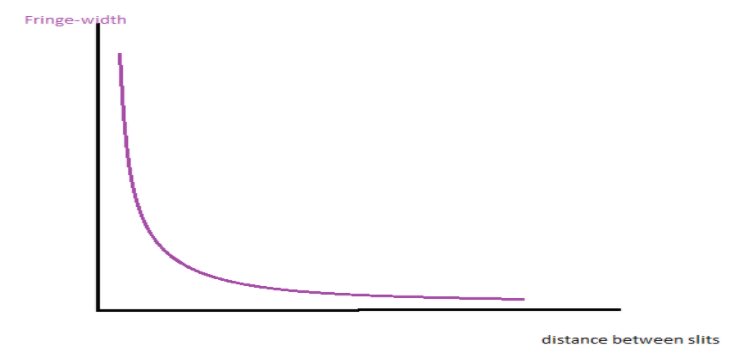
What is the nature of the graph between the separation of the slits and fringe width in case of young’s double slit experiment ?
A) Straight line with negative slope.
B) Straight line with positive slope.
C) Rectangular hyperbola
D) None of these
Answer
216k+ views
Hint: Young’s double slit experiment is a demonstration that light and matter can display characteristics of both classically defined waves and particles. he observed that as the difference /distance between the slits is decreased the fringe width obtained has more width, he concluded that both have inverse relationship as \[fringe\;width(\beta ) \propto \dfrac{1}{{separation\;between\;slits}}\]and when he plotted the data collected this was resembling a shape called rectangular hyperbola.
Complete step by step solution:
We know that the fringe width (\[\beta \]) in case of young’s double slit experiment is given by \[fringe\;width(\beta ) = \lambda \dfrac{D}{d}\] ,
From this equation we conclude that,
\[fringe\;width(\beta ) \propto \dfrac{1}{{separation\;between\;slits}}\]
\[fringe\;width(\beta ) \propto \dfrac{1}{d}\] ; separation between the slits = d.
It means that ;
\[ \Rightarrow \beta d = \]constant.
As we know the graph of \[xy = \]constant is a rectangular hyperbola. Here is the graph between the fringe-width and the separation between slits in Young's double slit experiment.

Hence option (C) is the correct answer.
Historically, Young's double slit experiment was first carried out by Young in 1801. This experiment demonstrated that light was a wave.
Young’s double slit experiment uses two coherent sources of light placed at a small distance apart, usually only a few orders of magnitude greater than the wavelength of light is used. Young’s double-slit experiment helped in understanding the wave theory of light which was proposed by Huygens .
Note: The double slit experiment was later conducted using electrons, and the pattern which generated was similar as expected with light. This surprised the world and it changed our understanding of matter and particles, forcing us to accept that matter like light also behaves like a wave.
Complete step by step solution:
We know that the fringe width (\[\beta \]) in case of young’s double slit experiment is given by \[fringe\;width(\beta ) = \lambda \dfrac{D}{d}\] ,
From this equation we conclude that,
\[fringe\;width(\beta ) \propto \dfrac{1}{{separation\;between\;slits}}\]
\[fringe\;width(\beta ) \propto \dfrac{1}{d}\] ; separation between the slits = d.
It means that ;
\[ \Rightarrow \beta d = \]constant.
As we know the graph of \[xy = \]constant is a rectangular hyperbola. Here is the graph between the fringe-width and the separation between slits in Young's double slit experiment.

Hence option (C) is the correct answer.
Historically, Young's double slit experiment was first carried out by Young in 1801. This experiment demonstrated that light was a wave.
Young’s double slit experiment uses two coherent sources of light placed at a small distance apart, usually only a few orders of magnitude greater than the wavelength of light is used. Young’s double-slit experiment helped in understanding the wave theory of light which was proposed by Huygens .
Note: The double slit experiment was later conducted using electrons, and the pattern which generated was similar as expected with light. This surprised the world and it changed our understanding of matter and particles, forcing us to accept that matter like light also behaves like a wave.
Recently Updated Pages
Wheatstone Bridge Explained: Working, Formula & Uses

Young’s Double Slit Experiment Derivation Explained

JEE Atomic Structure and Chemical Bonding important Concepts and Tips

JEE Amino Acids and Peptides Important Concepts and Tips for Exam Preparation

Electricity and Magnetism Explained: Key Concepts & Applications

Chemical Properties of Hydrogen - Important Concepts for JEE Exam Preparation

Trending doubts
JEE Main 2026: Application Form Open, Exam Dates, Syllabus, Eligibility & Question Papers

Derivation of Equation of Trajectory Explained for Students

Hybridisation in Chemistry – Concept, Types & Applications

Understanding the Angle of Deviation in a Prism

Understanding Collisions: Types and Examples for Students

How to Convert a Galvanometer into an Ammeter or Voltmeter

Other Pages
JEE Advanced Marks vs Ranks 2025: Understanding Category-wise Qualifying Marks and Previous Year Cut-offs

Ideal and Non-Ideal Solutions Explained for Class 12 Chemistry

Degree of Dissociation: Meaning, Formula, Calculation & Uses

Understanding Electromagnetic Waves and Their Importance

Understanding the Electric Field of a Uniformly Charged Ring

Understanding Average and RMS Value in Electrical Circuits




